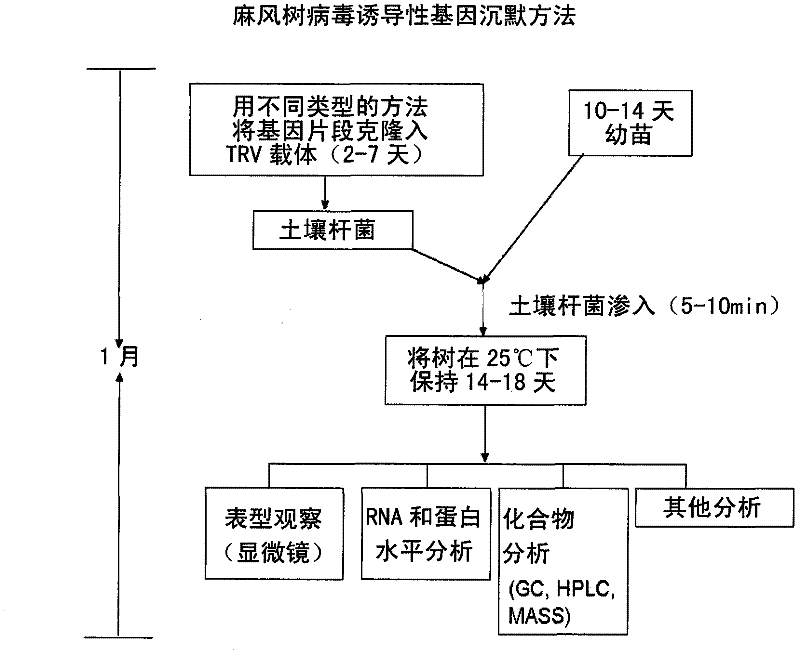Functional Analysis of Jatropha Genes
一种麻风树属、基因的技术,应用在基因工程、植物基因改良、生物化学设备和方法等方向,能够解决不适用高通量分析、费力费时等问题
- Summary
- Abstract
- Description
- Claims
- Application Information
AI Technical Summary
Problems solved by technology
Method used
Image
Examples
Embodiment 1
[0089] Embodiment 1 Experimental method
[0090] Jatropha seedlings: Jatropha seeds purchased from India were germinated in a greenhouse. Jatropha seedlings 10-14 days after germination were used for the VIGS method. At this stage, the seedlings have 2-3 true leaves.
[0091] Original TRV vectors: pTRV1 (GenBank No.AF406990) and pTRV2 (GenBank No.AF406991) were kindly provided by Dr. Dinesh Kumar (Yale University).
[0092] Synthetic TRV RNA1 expression vector: The full-length (7756bp) sequence of the synthetic TRV1 vector includes: SphI site, T-DNA right border sequence (152bp), repeated cauliflower mosaic virus (CaMV) 35S enhancer region (752bp) (Shi et al. al., 1997), TRV Ppk20 strain RNA1 (6791bp), subterranean clover mottle virus satellite RNA ribozyme sequence (46bp) and SmaI site sequence. The endogenous SalI site divides the full-length sequence into two parts. These two parts were synthesized separately and cloned into pGH vector to obtain two vectors pGH-YeJ-V1-1...
Embodiment 2
[0105] Example 2 Development of a VIGS system using CH42 as a marker gene in Jatropha curcas
[0106] This example describes the construction of a tobacco rattle virus (TRV)-based vector and its use in gene silencing of Jatropha curcas. Virus-induced gene silencing (VIGS) is initiated when a recombinant virus carrying a sequence derived from a host gene infects a plant. Transcripts of endogenous genes with sequences homologous to the insert in VIGS vectors are degraded by post-transcriptional gene silencing mechanisms (PTGS) (Baulcombe, 2004).
[0107] Initially, a TRV vector kindly provided by Dr. Dinesh Kumar (Yale University) was used in this study. TRV is a bisense RNA virus. TRV RNA1 encodes 134 kDa and 194 kDa replicase proteins from genomic RNA, a 29-kDa mobile protein, and a 16-kDa cysteine-rich protein from subgenomic RNA. TRV RNA2 encodes a coat protein from genomic RNA and two nonstructural proteins from subgenomic RNA. In the absence of RNA2, TRV RNA1 can repli...
Embodiment 3
[0113] Example 3 Optimization of a VIGS system by vacuum infiltration
[0114] Following the CH42 gene, we next chose to silence another marker gene, phytoene desaturase (PDS), which encodes a key enzyme involved in carotenoid biosynthesis. Silencing of the PDS gene inhibits carotenoid biosynthesis, which causes chlorophyll photooxidation and destruction under high light intensities and leads to photobleached leaves.
[0115] To amplify PDS homologs from Jatropha, PCR primers were designed to target conserved sequences of PDS from different species of Euphorbiaceae. First, we obtained the 302-bp PDS cDNA of Jatropha curcas by PCR and inserted this fragment into pTRV2 to obtain pTRV2-PDSS. Using this short PDS sequence as a seed, the longer EST sequences of different Euphorbiaceae PDS genes were searched in GenBank by BLASTN. We further designed PCR primers to clone the 786-bp fragment of Jatropha PDS cDNA to generate pTRV2-PDSL.
[0116] A mixture of Agrobacterium cultures ...
PUM
 Login to View More
Login to View More Abstract
Description
Claims
Application Information
 Login to View More
Login to View More - R&D
- Intellectual Property
- Life Sciences
- Materials
- Tech Scout
- Unparalleled Data Quality
- Higher Quality Content
- 60% Fewer Hallucinations
Browse by: Latest US Patents, China's latest patents, Technical Efficacy Thesaurus, Application Domain, Technology Topic, Popular Technical Reports.
© 2025 PatSnap. All rights reserved.Legal|Privacy policy|Modern Slavery Act Transparency Statement|Sitemap|About US| Contact US: help@patsnap.com



